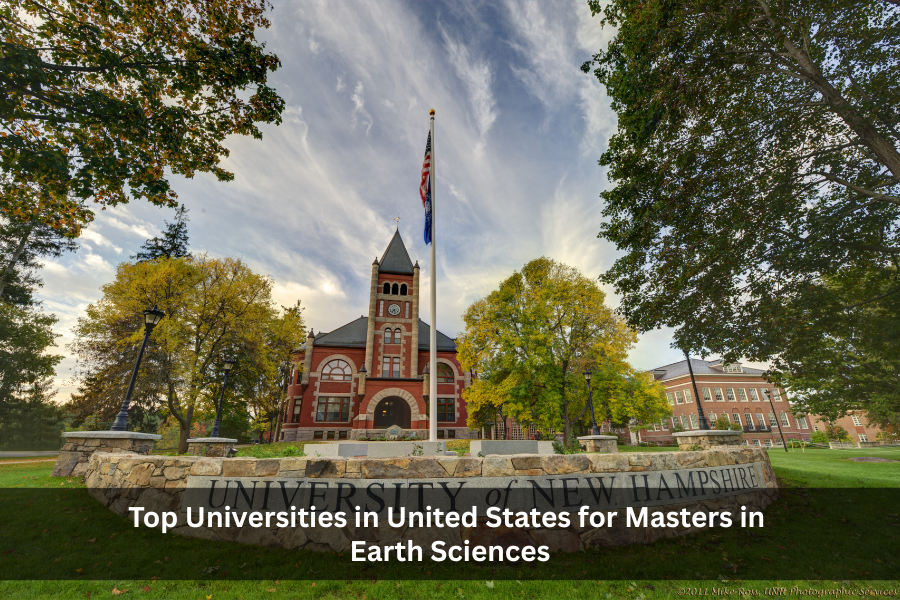
United States is a top choice for MS in Earth Sciences applicants, offering renowned universities, diverse campuses, and excellent post-study work options. Its high quality of life and career opportunities make it an ideal study destination.
Here is the list of 5 Best MS in Earth Sciences Universities in United States along with details of their course duration, fee, eligibility requirements and more:
1. George Mason University (United States)
George Mason University (George Mason, Mason, or GMU) is a public research university in Fairfax County, Virginia with the an independent City of Fairfax, Virginia postal address in the Washington, D.C. Metropolitan Area. The university was originally founded in 1949 as a Northern Virginia regional branch of the University of Virginia. Named after the Founding Father of the United States George Mason in 1959, it became an independent university in 1972. The school has since grown into the largest public university in the Commonwealth of Virginia.
George Mason University offers a 2-year STEM-designated Master of Science (MS) in Climate Science with a concentration in Climate Data through its College of Science. The program is designed to train students in analyzing and interpreting climate data, preparing them for roles in organizations that apply climate science results. Estimated annual tuition is approximately USD 18,000 for domestic students and USD 40,300 for international students, with living expenses around USD 35,000 per year.
2. University of New Hampshire (United States)
The Morrill Act of 1862 granted federal lands to New Hampshire for the establishment of an agricultural-mechanical college. In 1866, the university was first incorporated as the New Hampshire College of Agriculture and the Mechanic Arts in Hanover, New Hampshire, in association with Dartmouth College. The institution was officially associated with Dartmouth College and was directed by Dartmouth’s president. Durham resident Benjamin Thompson left his farm and assets to the state for the establishment of an agricultural college. On January 30, 1890, Benjamin Thompson died and his will became public. On March 5, 1891, Governor Hiram A. Tuttle signed an act accepting the conditions of Thompson’s will. On April 10, 1891, Governor Tuttle signed a bill authorizing the college’s move to Durham, New Hampshire.
The University of New Hampshire offers a 2-year STEM-designated Master of Science (MS) in Earth Sciences through the College of Engineering & Physical Sciences. The program encompasses various disciplines, including atmospheric sciences, hydrology, geochemistry, geology, and oceanography, with a particular emphasis on geospatial analysis of earth systems, regional climate analysis, and modeling of earth processes and changes . Estimated annual tuition is approximately USD 15,900 for domestic students and USD 29,900 for international students, with living expenses around USD 21,800 per year.
3. University of Oregon (United States)
The University of Oregon (UO, U of O or Oregon) is a public flagship research university in Eugene, Oregon. Founded in 1876, the institution’s 295-acre campus is situated along the Willamette River. Since July 2014, UO has been governed by the Board of Trustees of the University of Oregon. The university is classified among “R1: Doctoral Universities – Very high research activity” and is a member of the Association of American Universities.
The University of Oregon offers a 2-year STEM-designated Master of Science (MS) in Earth Sciences through the College of Arts and Sciences. The program emphasizes rigorous training in scientific research, including hypothesis formulation, data collection, and interpretation, culminating in a thesis approved by a faculty committee. Students can specialize in areas such as volcanology, geochemistry, geophysics, and paleontology. Estimated annual tuition is approximately USD 19,473 for domestic students and USD 33,378 for international students, with living expenses around USD 15,846 per year.
4. Arizona State University (United States)
Arizona State University is a public research university in the Phoenix metropolitan area. Founded in 1885 by the 13th Arizona Territorial Legislature, ASU is one of the largest public universities by enrollment in the U.S.
Arizona State University offers a 2-year STEM-designated Master of Science (MS) in Exploration Systems Design through the College of Liberal Arts & Sciences. The program integrates science applications with engineering knowledge and skills, focusing on Earth science, space science, and astrophysics. Students engage in a curriculum that includes core courses, electives, and a culminating experience, totaling 30 credit hours. Estimated annual tuition is approximately USD 13,900 for domestic students and USD 43,100 for international students, with living expenses around USD 24,000 per year.
5. California State University, Los Angeles (United States)
California State University, Los Angeles (Cal State LA) is a public university in Los Angeles, California. It is part of the 23-campus California State University (CSU) system. Cal State LA offers 142 bachelor’s degrees, 122 master’s degrees, and four doctoral degrees: a Doctor of Philosophy (Ph.D.) in special education in collaboration with the University of California, Los Angeles (UCLA), a Doctor of Education (Ed.D.) in Educational Leadership, a Doctor of Nursing Practice (DNP) and a Doctor of Audiology (AuD). It also offers 22 teaching credentials.
California State University, Los Angeles offers a 2-year STEM-designated Master of Science (MS) in Geological Sciences through the College of Natural & Social Sciences. The program provides students with a strong foundation in both theoretical and practical aspects of geology, allowing them to choose between two focused areas of study. The curriculum requires 30 semester units, including 15 units of 5000-level courses selected with advisor approval. All students must complete either a thesis or a comprehensive examination as part of the program requirements. Estimated annual tuition is approximately USD 9,144 for domestic students and USD 15,000 for international students, with living expenses around USD 29,600 per year.
If you’re planning to study in United States, check out our comprehensive guide covering everything you need to know from top universities and popular programs to career prospects, tuition fees, cost of living, scholarships, visas, and more.
 |
 |
 |
 |
 |
 |
 |
 |
